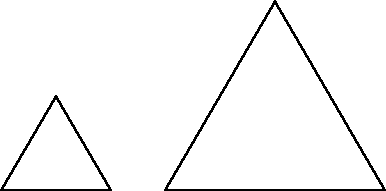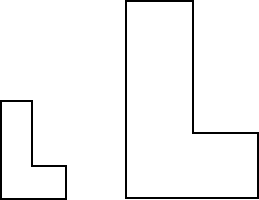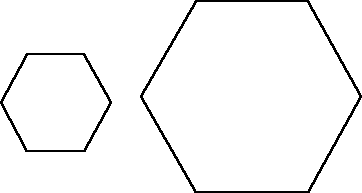Copyright © University of Cambridge. All rights reserved.
'Two Squared' printed from https://nrich.maths.org/
Show menu
Why do this problem?
This problem helps learners to come to terms with the concept of area and also to explore the properties of many straight-sided shapes. It requires some quite difficult visualisation when more complex shapes are used. However, the beginning is very accessible so everyone can become involved quickly.
Possible approach
You could start by showing the group the beginning of the problem on the interactive whiteboard by creating multiple copies of one square and then another square with sides double the length. Alternatively, you could cut out squares to attach to a board. Ask children how many of the small squares will be needed to cover the large square and encourage them to picture how they would do this,
then to describe it. Depending on the group, it might be a good idea to continue by looking at the equilateral triangle all together, which is the first shape that is not entirely simple because one triangle has to be inverted. Again, ask the learners to visualise how they think the four triangles will fit before doing any sketching or manipulating.
Learners can then work in pairs on the problem from these two sheets so that they are able to talk through their ideas with a partner. Scissors are essential and it also helps to have both squared and isometric paper available for recording. This should be 'dotty paper'
if possible, as it is easier to see the shapes if only the necessary lines are drawn. (Click here for dotty isometric paper.) Encourage learners to visualise what they are going to do before they embark on each new shape.
Some of the later shapes require considerable manipulation to fit in the four smaller shapes. The hexagons are likely to prove the first real difficulty and children will reach different solutions. They may need to count little triangles on the isometric paper to be convinced that they have actually fitted four hexagons into the larger one. Possibly the simplest solution is to cut one hexagon into three rhombi and fit all together like this:

If many learners are having difficulties, the diagram above could be drawn on the board. Isometric paper can be very useful at this point.
At the end, with the whole group together, some solutions and sketches could be discussed. You may want to draw out the fact that doubling the sides of the shape has resulted in four times the area, not double the area. With very visual work such as this some children show unexpected talent and others, who usually succeed at once, have blocks. This means that it is specially helpful if later the children have a few minutes to jot down their feelings.
How did you feel if you got stuck?
What or who helped you?
How did you feel when you cracked the problem?
Key questions
What do you need to do to fit in this shape?
What have you tried so far?
How will you remember how the shapes fitted together?




